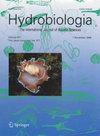利用珊瑚礁功能指数评价马里塔斯岛国家公园珊瑚礁的主动恢复
IF 0.3
4区 生物学
Q4 MARINE & FRESHWATER BIOLOGY
引用次数: 0
摘要
背景。珊瑚礁是最具生物多样性的海洋生态系统之一,除了提供极具价值的地质生态功能外。然而,它们受到各种环境压力因素以及人为因素的影响。针对上述情况,已经实施了积极的恢复措施,例如玛丽埃塔斯岛国家公园(PNIM)的珊瑚群落。的目标。本研究旨在利用2014年和2021年PNIM珊瑚礁的珊瑚礁功能指数(IFA)来评估珊瑚恢复对物理功能(FF)的影响。方法。IFA被用作FF度量,因为它是一种更完整的评估方法。IFA考虑了三个生态属性:珊瑚覆盖(CC)、钙化率和结构复杂性。在PNIM内的两个地点计算IFA,区分恢复(R)和未恢复(NR)样带。结果。2个样地的R样地中,礁体在CC区和FF区均有较大的增加(%),CC区增加了139 ~ 173%,FF区增加了31 ~ 34%。相比之下,NR样带CC增加了9-31%,FF增加了8-25%。结论。本研究的数据表明,在PNIM中使用髋孔体碎片的修复在物理功能方面是有效的。由于该属对FF的高贡献,与没有干预的样带相比,主动恢复的样带的珊瑚礁结构得到更大程度的恢复。本文章由计算机程序翻译,如有差异,请以英文原文为准。
Evaluation of active restoration through the reef functional index in reefs of the Islas Marietas National Park
Background. Coral reefs are one of the most biodiverse marine ecosystems, in addition to providing highly valuable geo-ecological functions. However, they are affected by various environmental stressors, as well as those of anthropogenic origin. In response to the above, active restoration measures have been implemented, as in the case of the coral community of the Islas Marietas National Park (PNIM). Goals. This work aims to evaluate the effect of coral restoration on physical functionality (FF) by using the reef functional index (IFA), in PNIM reefs in the years 2014 and 2021. Methods. The IFA was used as a FF metric, since it is a more comple-te way of evaluating it. The IFA considers three ecological attributes: coral cover (CC), calcification rate, and structural complexity. The IFA was calculated at two sites within the PNIM, differentiating between restored (R) and unrestored (NR) transects. Results. The reefs showed a greater increase (%) in the R transects for both sites, both in the CC and in the FF, the CC increased between 139-173% and the FF between 31-34%. In contrast to the NR transects where the increase was 9-31% in CC and 8-25% in FF. Conclusion. The data from this study reveal that the restoration in the PNIM using fragments of pociloporids is being effective in terms of physical functionality. Due to the high contribution to the FF that the genus has, the reef structure is being recovered to a greater extent in transects with active restoration compared to transects in which there is no intervention.
求助全文
通过发布文献求助,成功后即可免费获取论文全文。
去求助
来源期刊

Hidrobiologica
生物-海洋与淡水生物学
CiteScore
0.40
自引率
0.00%
发文量
8
审稿时长
>12 weeks
期刊介绍:
HIDROBIOLÓGICA es una publicación cuatrimestral que difunde trabajos originales e inéditos de investigación o revisión, sobre temas relacionados con los organismos y la hidrología de los ambientes acuáticos, dulces y marinos y va dirigida a investigadores de todo el mundo, interesados en las diversas disciplinas que incluye la Hidrobiología , así como a alumnos de posgrados y licenciaturas relacionados con la biología, ecología, taxonomía, filogenia y evolución de organismos acuáticos, e hidrología y oceanografía de ambientes s dulceacuícolas y marinos.
 求助内容:
求助内容: 应助结果提醒方式:
应助结果提醒方式:


